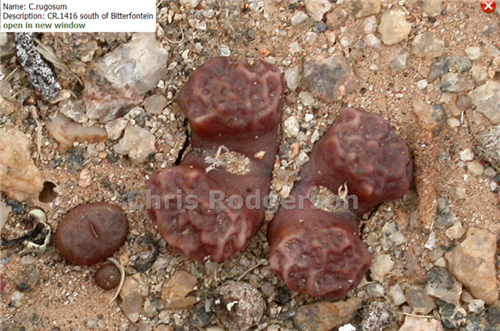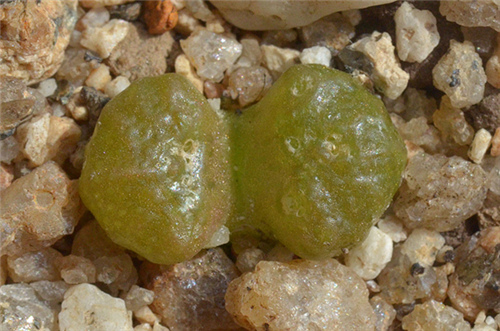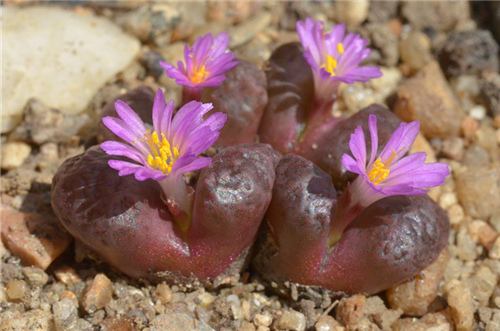

conophytum rugosum CR1416


Conophytum rugosum R&Y 1969
Article from http://www.smale-conophytum.co.uk/
My other three problem conos are all in the section Cylindrata. Conophytum rugosum is wide-spread through Namaqualand and is much easier to see, such that I have found and photographed a number of colonies as have my various cono-ecotourist friends. It can be found growing on the 500 million year old eroded gneiss domes that are so characteristic of the area along with C. pellucidum and pageae; C. obcordellum subsp. stenandrum and C. minutum can also occur on the same domes in the southern part of its range. The colonies of C. rugosum that I have observed have tended to grow in grit pans near the base of the domes, whereas C. pellucidum and pageae have been higher up. When the winter rains fall, the run-off from the domes can be expected to create a moister environment on the low parts of the domes where they start to flatten out, so I wonder if problems in growing the species are associated with us giving it too little water? There is some variation in the colonies that I have seen, particularly in the colour of the bodies that can vary from green to brown. Flowers are small suggesting that it has given up the idea of attracting pollinators and that it is happy with self-fertilisation.
The first problem with C. rugosum is germinating the seed. I have always had a low success rate, maybe 5 – 20%, and germination is very slow, usually taking at least a month. I sow in January with bottom heat that raises the temperature about 5oC above ambient. I do not keep good records, but get the impression that germination is best when January is cold and bright. This results in my seed unit having a wide diurnal variation from about 8oC at night to over 20oC in the day and I suspect that this wide fluctuation is beneficial. Seedlings usually grow on quite well for the first couple of years but then seem to run into problems and start dying or at least some heads in a clump die or fail to expand when watered in the autumn. This is a problem that also occurs with various forms of C. roodiae and C. buysianum which are also in the section Cylindrata. The best solution to perpetuating these taxa seems to be to regularly pull the heads apart and replant in new compost. This is easier than it sounds because C. rugosum, C. buysianum and most forms of C. roodiae are mat-formers and each head independently forms roots as the mat grows. So they can be easily pulled apart into separate heads that already have roots. C. reconditum grows in the same way but does not seem to suffer from the same die-back problem, it simply succumbs to sunburn if not given some shade in the summer. I have maintained some stocks of C. rugosum for quite a long time but they eventually seem to disappear unless repropagated from seed.
翻译:我的其他三个问题conos都在Cylindrata部分中。Conophytum rugosum在纳马夸兰岛(Namaqualand)广为流传,而且很容易看到,所以我和生态旅游的朋友发现并拍摄了许多殖民地的照片。可以发现它生长在具有5亿年历史的侵蚀片麻岩穹顶上,该穹顶与该地区的 C. pellucidum和 pageae一样具有特征。 C. obcordellum subsp. stenandrum和C. minutum也可以出现在其范围的南部相同的圆顶上。我观察到的 C. rugosum的聚居地倾向于在圆顶底部附近的沙砾盘中生长,而C. pellucidum和pageae则更高。当冬季降雨降临时,可以预见圆顶的径流会在圆顶的低处开始平坦的地方形成潮湿的环境,所以我想知道是否给我们提供了这种物种会带来物种生长方面的问题水太少了吗?我看到的聚居地有些变化,尤其是身体的颜色可能从绿色变为棕色。花朵很小,花朵很小,这表明它已经放弃了吸引传粉者的想法,它对自我受精很满意。
C.rugosum的第一个问题是使种子发芽。我的成功率一直很低,可能是5-20%,发芽非常缓慢,通常至少需要一个月。我在一月份播种的时候是底部加热,将温度提高到比周围环境高5oC。我没有保留好的记录,但给人的印象是在一月的寒冷和明亮时发芽最好。这导致我的种子单元的昼夜变化很大,从晚上的8oC到白天的20oC以上,我怀疑这种较大的波动是有益的。幼苗通常在头几年生长良好,但随后似乎遇到问题并开始死亡,或者至少在秋天结块时有些团簇死亡或在秋季浇水时无法扩展。对于也在圆柱体部分中的各种形式的C. roodiae和C. buysianum也会出现此问题。使这些分类单元永存的最佳解决方案似乎是定期将头分开并重新种植新的堆肥。这比听起来容易,因为C.rugosum, C. buysianum和大部分的C. roodiae都是垫子的框架,并且每个头随着垫子的生长而独立地形成根。因此,它们可以轻松地拉成已经有根的单独的头部。C. reconditum以相同的方式生长,但似乎没有遭受同样的消亡问题,如果夏天不加阴影,它只会屈服于晒伤。我已经保存了很长一段时间的C. rugosum种群,但是除非从种子中繁殖出来,否则它们最终似乎消失了。